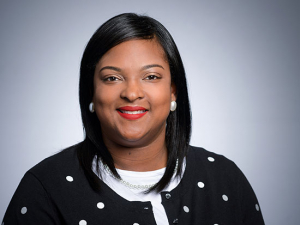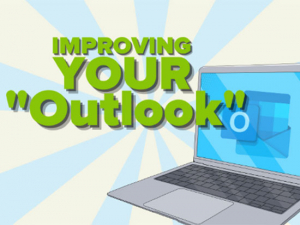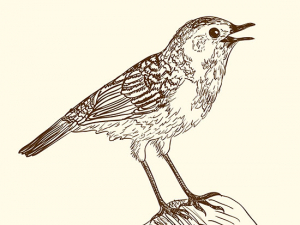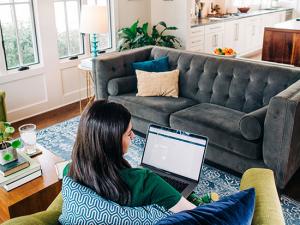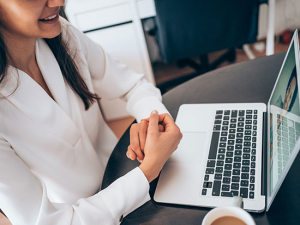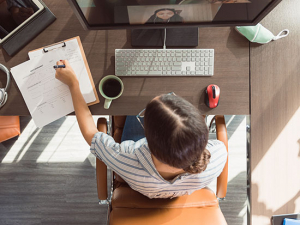 |
| UAB's new Digital Media Commons features an open resource lab and this adjacent media classroom in rooms 342 and 334 in Heritage Hall. Rosie O'Beirne (third from left), director of digital media and learning, says the rooms provide a full menu of multimedia applications unlike any other lab on campus. |
More than 1.5 billion people are connected to the Internet, according to Intel, which projects that number to double by the end of 2015. There are more than 26 million iPhone users in the United States and more than 43 million Android users, says ComScore, a global leader in measuring the digital world.
And while it’s hard to find one definitive source, the general consensus is that worldwide, there are more than 5 billion feature phones, 500 million smart phones and 60 million tablets and e-readers. And all of these numbers? They’re trending up as new products and software continue to hit the marketplace at a frenetic pace.
Yes, the digital world is alive and kicking, and UAB’s College of Arts & Sciences is aggressively embracing it with hands-on learning of digital literacy, citizenship and skills through the creation of the Digital Media Commons — an open resource lab and corresponding media classroom for faculty, staff and students.
“Digital and media skills are as important as writing in today’s world, which is ultimately why the lab and classroom were created,” says Rosie O’Beirne, director of digital media and learning, a new College of Arts & Sciences entity that includes the Digital Media Commons and a variety of digital initiatives that interface with faculty and students.
| Digital Media Commons Heritage Hall Rooms 342 and 334Open access resource lab for faculty, staff, students
|
The interdisciplinary multi-media rooms were made possible through donor support and College of Arts & Sciences departments that pooled their resources together to invest in students by creating an all-Mac lab and classroom that offers full editing options.
Faculty, staff and students can edit videos using Final Cut Pro, Adobe Premiere 6 and Avid Media Composer — all industry standards in documentary filmmaking and Hollywood films.
“We have a full menu of multimedia applications that is not like any other lab on campus,” O’Beirne says. “The combination of applications we have make this unique. There are a few other Mac labs, but you won’t be able to walk into one that has the slate of options we have for the students.”
Colin Albea, a senior film and history double major and Homewood native, completed an internship at Duncan Scott Productions in Santa Monica, Calif., this past summer and says UAB has the necessary tools in place to make students competitive in the job market.
“I had to do a lot of editing, and thankfully I was able to jump right in due to the experience I already had at UAB with both Final Cut Pro and Adobe Premier Pro,” Albea says. “I can certainly attest that the software and programs available in this lab prepare students for real jobs in the film and media world.”
O’Beirne says this type of digital media availability is rare around the country. In fact, students from institutions including Harvard, Brandeis and Northwestern that visited campus this summer were stunned by the investment.
“These students were from really select schools, and when they walked into this place, their mouths dropped,” O’Beirne says. “They said they didn’t have anything like this.”
|
Student collaboration
Many students come to school already knowing how to edit on some platforms. O’Beirne says today’s students are more likely to pick up a camera or cell phone to document their experiences and then use multimedia to share with each other or the public.
Many UAB courses now require students to use digital media as part of their assignments. Students from history, art, theater, English and other disciplines already have used the open resource lab.
“We’ve had chemistry students coming in here to edit the experiments they have filmed and want to submit online,” O’Beirne says. “They need a place to put together a two-minute sequence for a chemistry assignment. But the idea is to have a whole range of students from different disciplines using this space.”
The new media classroom, which is available for use by any media-based class on campus, is nothing like the rigid teacher-student classrooms of old.
Student desks are now laptop stations that foster digital collaboration. Users can plug in their own laptops (or the ones provided) and share a collective screen for group discussion.
“I had a class in this room in the spring before it was upgraded, and it’s just completely different in terms of equipment available and setup,” says Katelyn Armstrong, a senior graphic design major from Madison. “The computers were all around the outside of the room, and we had one big table in the middle we had to crowd around to have a group discussion. Now it’s a lot more open and there’s more room to move around, talk to your peers and get feedback from them. Plus the teachers can use the video screens to show work taking place at any of the stations in the room. It’s really a better learning environment.”
 Kevin Franks, a junior civil engineering major from Hayden, says the setup of the open resource lab and classroom encourages students to work together.
Kevin Franks, a junior civil engineering major from Hayden, says the setup of the open resource lab and classroom encourages students to work together.
“All of the classes we take in this area are interdisciplinary and so hands on,” Franks says. “You really do need people around the help you with it. This environment makes it so much easier on the students for that experiential learning. It makes sharing with one another so much easier.”
O’Beirne sees the students interact with each other daily. It’s not uncommon for her to see a graphic design student helping another student create a title for a movie, and the receiving student return the favor by helping the graphic design student with their editing.
“Or if someone needs a piece of music for a public service announcement they are editing, I’ve seen a student who is in here editing say, ‘Oh, I have a piece of music. Let me hand that off to you,’” O’Beirne says. “They’re collaborating in ways that we have to in real life.”
The Digital Media Commons is accepting donations for the facility, including sponsorship of the open resource lab and classroom. For more information, visit www.uab.edu/mediacommons.












